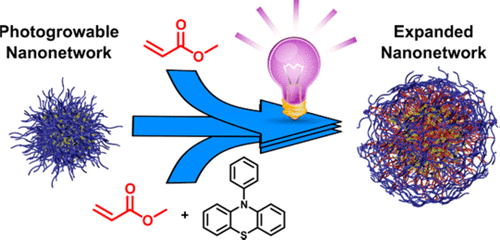当前位置:
X-MOL 学术
›
ACS Macro Lett.
›
论文详情
Our official English website, www.x-mol.net, welcomes your
feedback! (Note: you will need to create a separate account there.)
Photocontrolled Growth of Cross-Linked Nanonetworks
ACS Macro Letters ( IF 5.1 ) Pub Date : 2018-06-06 00:00:00 , DOI: 10.1021/acsmacrolett.8b00290 Michael W Lampley 1, 2 , Eva Harth 1
ACS Macro Letters ( IF 5.1 ) Pub Date : 2018-06-06 00:00:00 , DOI: 10.1021/acsmacrolett.8b00290 Michael W Lampley 1, 2 , Eva Harth 1
Affiliation

|
We report the preparation of photoresponsive nanomaterials and the increase of their nanoscopic size through a “photogrowth” mechanism. The photogrowable nanonetworks (PGNNs) were synthesized by cross-linking two components, a thiolated acrylate copolymer and a symmetrical bismaleimide trithiocarbonate (TTC), utilizing thiol-maleimide click chemistry. With this strategy, nanonetwork growth was achieved through a photoinduced polymerization from the integrated trithiocarbonate by either direct photolysis or photoredox catalysis. Via direct photolysis, we generated a series of expanded particles by polymerizing methyl acrylate (MA) under irradiation with violet light (400 nm) over a period of 1, 3, and 6 h, starting from a 58 nm parent particle, resulting in particles of increased sizes of 77, 156, and 358 nm, respectively. Nanoparticle expansion reactions catalyzed by 10-phenylphenothiazine (PTH) were experienced to progress faster in 20 and 30 min to reach particle sizes of 195 and 300 nm. The addition of the photoredox catalyst to the expansion polymerizations with MA resulted in an increased control over the dispersity of the particles as well as of the promoted disassembly products. In this work, we demonstrated that nanoparticle structures designed as cross-linked networks with integrated trithiocarbonates can be expanded by photocontrolled radical polymerizations (photo-CRPs) in the presence or absence of a photoredox catalyst. These proof-of-concept experiments showcase the dynamic growth and integration of functional units into existing scaffolds and open up the possibility to prepare highly tailorable nanomaterials.
中文翻译:

交联纳米网络的光控生长
我们报告了光响应纳米材料的制备以及通过“光生长”机制增加其纳米尺寸。利用硫醇-马来酰亚胺点击化学,通过交联两种组分,一种硫醇化丙烯酸酯共聚物和一种对称的双马来酰亚胺三硫代碳酸酯 (TTC),合成了可光生长的纳米网络 (PGNN)。使用这种策略,纳米网络的生长是通过直接光解或光氧化还原催化从整合的三硫代碳酸盐光诱导聚合来实现的。通过直接光解,我们通过在紫光 (400 nm) 照射下聚合丙烯酸甲酯 (MA) 生成一系列膨胀粒子,时间为 1、3 和 6 小时,从 58 nm 母体粒子开始,产生粒子分别增加了 77、156 和 358 nm 的尺寸。由 10-苯基吩噻嗪 (PTH) 催化的纳米颗粒膨胀反应在 20 和 30 分钟内进展更快,达到 195 和 300 nm 的粒径。将光氧化还原催化剂添加到 MA 的膨胀聚合中导致对颗粒分散性以及促进的分解产物的控制增加。在这项工作中,我们证明了设计为具有集成三硫代碳酸酯的交联网络的纳米颗粒结构可以在存在或不存在光氧化还原催化剂的情况下通过光控自由基聚合 (photo-CRPs) 进行扩展。这些概念验证实验展示了功能单元的动态生长和集成到现有支架中,并开辟了制备高度可定制的纳米材料的可能性。
更新日期:2018-06-06
中文翻译:

交联纳米网络的光控生长
我们报告了光响应纳米材料的制备以及通过“光生长”机制增加其纳米尺寸。利用硫醇-马来酰亚胺点击化学,通过交联两种组分,一种硫醇化丙烯酸酯共聚物和一种对称的双马来酰亚胺三硫代碳酸酯 (TTC),合成了可光生长的纳米网络 (PGNN)。使用这种策略,纳米网络的生长是通过直接光解或光氧化还原催化从整合的三硫代碳酸盐光诱导聚合来实现的。通过直接光解,我们通过在紫光 (400 nm) 照射下聚合丙烯酸甲酯 (MA) 生成一系列膨胀粒子,时间为 1、3 和 6 小时,从 58 nm 母体粒子开始,产生粒子分别增加了 77、156 和 358 nm 的尺寸。由 10-苯基吩噻嗪 (PTH) 催化的纳米颗粒膨胀反应在 20 和 30 分钟内进展更快,达到 195 和 300 nm 的粒径。将光氧化还原催化剂添加到 MA 的膨胀聚合中导致对颗粒分散性以及促进的分解产物的控制增加。在这项工作中,我们证明了设计为具有集成三硫代碳酸酯的交联网络的纳米颗粒结构可以在存在或不存在光氧化还原催化剂的情况下通过光控自由基聚合 (photo-CRPs) 进行扩展。这些概念验证实验展示了功能单元的动态生长和集成到现有支架中,并开辟了制备高度可定制的纳米材料的可能性。











































 京公网安备 11010802027423号
京公网安备 11010802027423号